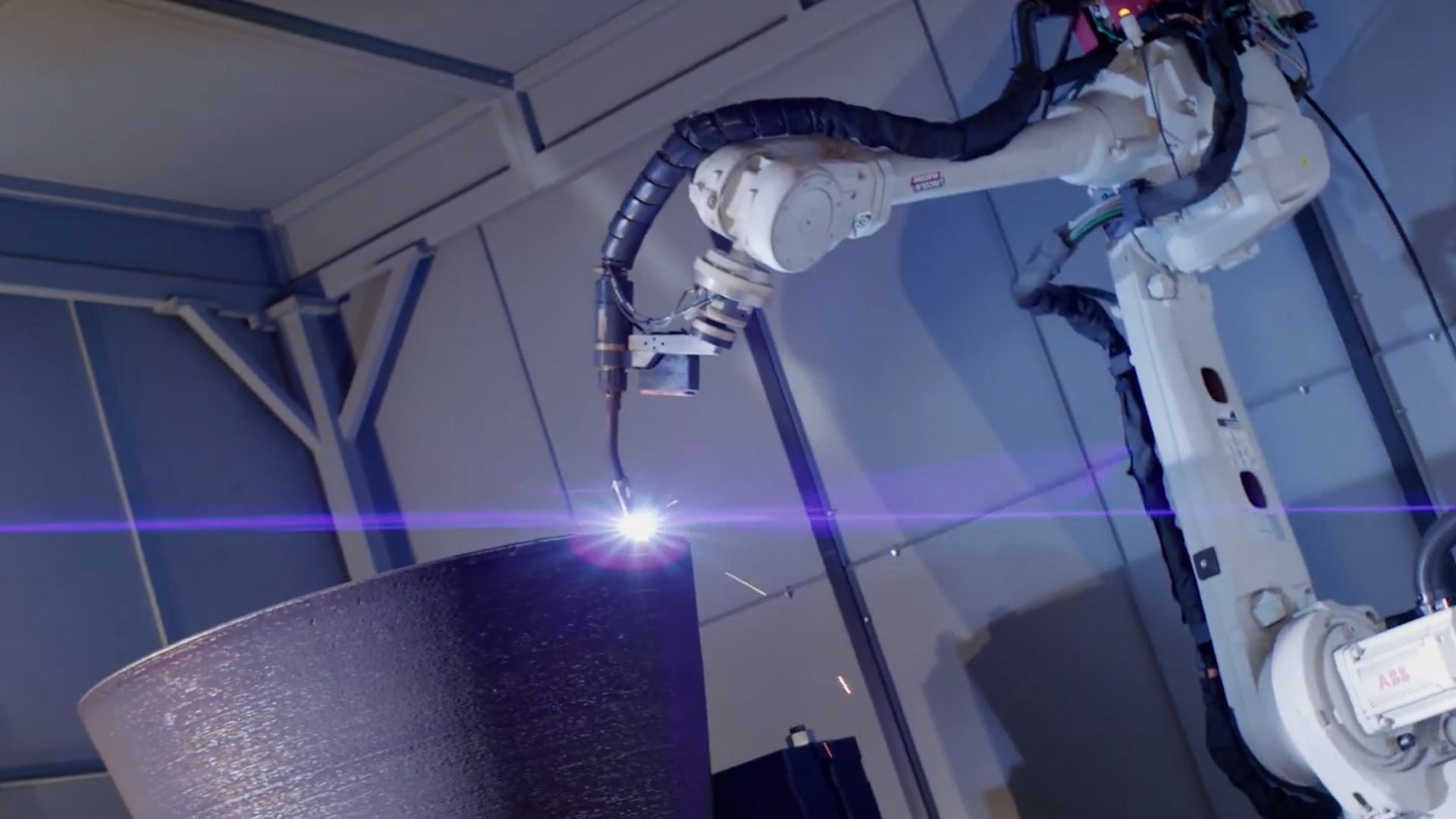
[RYAN ROBERTSON]
FOR AS MODERN AS AMERICA’S NATIONAL DEFENSE IS… THERE IS STILL A LARGE RELIANCE ON EQUIPMENT THAT IS DECADES OLD.
[RYAN ROBERTSON]
THE B-52 STRATOFORTRESS, THE CH-47 CHINOOK, AND THE M-61 VULCAN ARE ALL STILL IN SERVICE, ALL PREDATING MAN’S FIRST STEPS ON THE MOON.
[RYAN ROBERTSON]
THE REASON IS SIMPLE: THEY’RE STILL EFFECTIVE. BUT MAINTAINING EQUIPMENT THAT OLD CAN BE A CHALLENGE. PARTS THAT WERE ONCE EASY TO GET ARE NOW SCARCE OR, IN SOME CASES, NO LONGER BEING MADE. BUT THERE IS A SOLUTION… ONE THAT AMERICA’S MILITARY IS QUICKLY ADOPTING: ADDITIVE MANUFACTURING.
[ANIMATED TRANSITION]
[MACHINING NATS IF AVAILABLE FOR :03]
[RYAN ROBERTSON]
TO THE CASUAL OBSERVER, ADDITIVE MANUFACTURING MIGHT LOOK THE SAME AS 3-D PRINTING. BUT THERE IS A SLIGHT DIFFERENCE: SCALE. ESSENTIALLY, IT’S THE DIFFERENCE BETWEEN PRINTING A CHESS PIECE AT HOME AND CREATING A BALL VALVE DESTINED FOR A NAVY VESSEL. FOR EXAMPLE, PRINTING THIS HUNK OF METAL, THEN MACHINING IT INTO A FINISHED PIECE, READY TO BE INSTALLED ON A SUBMARINE. ANDY PFISTER OF FAIRBANKS MORSE DEFENSE TOLD US USING TRADITIONAL MEANS TO GET THE SAME PART COULD TAKE ANYWHERE FROM SIX TO 36 MONTHS.
[ANDY PFISTER]
“The big innovation with that, I can get that in six weeks. I’m going to get it in six weeks every single time. If I need it faster, I can even get it faster, and I know what I’m getting is good. I might have to put a little more machine time in it, you know, to take it down to what I see here, but it gives me that predictability and allows me to schedule and plan my work and increase our efficiency within our manufacturing environment.”
[RYAN ROBERTSON]
IT’S THE KIND OF EFFICIENCY THAT’S MAKING BELIEVERS OUT OF ANYONE INVOLVED IN THE PROCESS OF GETTING A BOAT IN THE WATER OR AN AIRCRAFT BACK IN THE SKY.
[ANDY PFISTER]
“We like to say valves are, you know, big enough to be important, but not so big, to drive the price of a boat, however, when you can’t deliver a valve, or when you can’t deliver a piece part that can drive the schedule for a ship and delivery of the ship to the Navy, which ultimately is one of the biggest cost drivers of these large programs. So anything we can do to get, you know, our customers in the war fighter what they need, when they need it is really going to, you know, help the supplier industrial race deliver on what, what the Navy needs.”
[RYAN ROBERTSON]
MEETING THOSE NEEDS IS IMPORTANT ENOUGH THAT NOW, EACH BRANCH OF THE DOD HAS WAYS TO TAKE THE PROCESS OUT OF THE FACTORY AND INTO THE BATTLE SPACE. FOR THE MARINE CORPS, THAT MEANS TURNING ADDITIVE MANUFACTURING INTO EXPEDITIONARY MANUFACTURING. TAKING THE PROCESS TO WHERE IT’S NEEDED THE MOST.
[SGT. SAMUEL MARGARINI]
“Now, not only are we focusing on parts that are made out of plastic, but we’re also focusing on parts that are made out of metal. So, one of those examples would be the fuel block. We had one that broke, and they brought it to us, and we metal 3D printed it.”
[RYAN ROBERTSON]
NOT TO BE OUTDONE, THE ARMY EMBRACED THE PROCESS AS WELL. THIS IS TIME-LAPSE VIDEO OF THE LARGEST U.S. CIVIL WORKS COMPONENT EVER PRODUCED BY ADDITIVE MANUFACTURING. IT’S A POE LOCK SHIP ARRESTOR USED TO SAFELY AND QUICKLY HALT A 100,000-TON VESSEL. USING CONVENTIONAL MANUFACTURING WOULD HAVE TAKEN 18 MONTHS; WITH ADDITIVE MANUFACTURING, IT WAS DONE IN 12 WEEKS, ALLOWING THE SOO LOCKS BETWEEN THE GREAT LAKES BORDER OF THE U.S. AND CANADA TO REOPEN IN MARCH OF THIS YEAR.
THE AIR FORCE IS GETTING IN ON THE ACTION TOO. IN 2018, HURRICANE MICHAEL FLATTENED PARTS OF TYNDALL AIR FORCE BASE IN FLORIDA. THE DEVASTATION WAS SO COMPLETE THE BASE IS STILL REBUILDING MUCH OF WHAT WAS LOST. IN 2023 THAT INCLUDED THIS PRINTED FACILITY FOR ROBOTICS RESEARCH. IT’S THE FIRST OF ITS KIND ON AN AIR FORCE BASE ANYWHERE IN THE WORLD.
[BRIAN SKIBBA]
“It does meet the new unified facility criteria, which is the military building code for 3d printed structures, but it also this is the first 3d printed building that we know of, especially in the military, that actually meets what’s called the Miami Dade win code standards.”
[RYAN ROBERTSON]
IT’S A TREND THAT SHOWS NO SIGNS OF SLOWING DOWN. ACCORDING TO VANTAGE MARKET RESEARCH, THE ADDITIVE MANUFACTURING INDUSTRY WAS VALUED AT $14.5 BILLION IN 2022 AND IS PROJECTED TO REACH A VALUE OF MORE THAN $69 BILLION BY 2030. THE DOD’S CHALLENGE NOW IS WIDESPREAD IMPLEMENTATION. BUILDING THE INFRASTRUCTURE THAT WILL ALLOW ADDITIVE MANUFACTURING TO SHORTEN SUPPLY CHAINS AND KEEP AMERICAN TROOPS IN FRONT OF THEIR NEAR-PEER ADVERSARIES.







